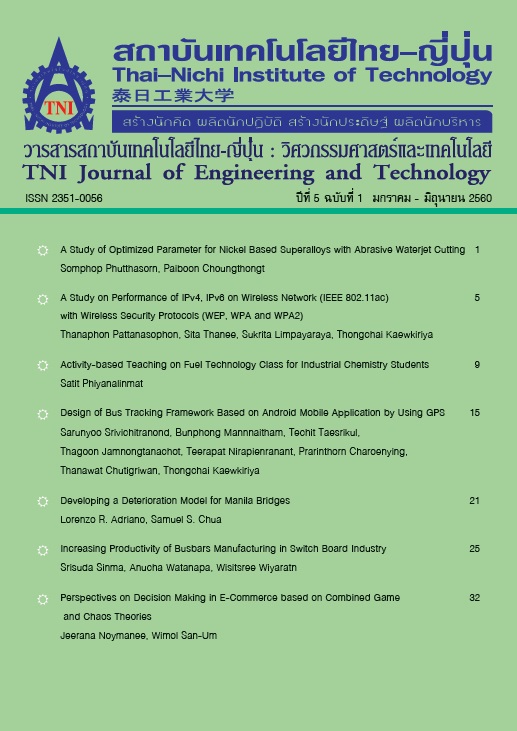Perspectives on Decision Making in E-Commerce based on Combined Game and Chaos Theories
Main Article Content
Abstract
This paper presents new paradigm on behaviours of decision making in E-commerce in Thailand through a perspective on game Theory and a chaos theory. As E-commerce is a multi-dimensional consideration, a single theory may not be sufficient for the overall perspective views in decision making. In this paper, game theory is suitable for decision making of E-commerce providers in order to set the strategy based on feedback information. However, chaos theory is suitable for describing customer decision making, especially the buying behaviors seems to be random in which the classical decision model cannot be described. The proposed new paradigm can be applicable for economics and managements in enterprise, especially business-tocustomer types of entrepreneurs.
Article Details
Article Accepting Policy
The editorial board of Thai-Nichi Institute of Technology is pleased to receive articles from lecturers and experts in the fields of engineering and technology written in Thai or English. The academic work submitted for publication must not be published in any other publication before and must not be under consideration of other journal submissions. Therefore, those interested in participating in the dissemination of work and knowledge can submit their article to the editorial board for further submission to the screening committee to consider publishing in the journal. The articles that can be published include solely research articles. Interested persons can prepare their articles by reviewing recommendations for article authors.
Copyright infringement is solely the responsibility of the author(s) of the article. Articles that have been published must be screened and reviewed for quality from qualified experts approved by the editorial board.
The text that appears within each article published in this research journal is a personal opinion of each author, nothing related to Thai-Nichi Institute of Technology, and other faculty members in the institution in any way. Responsibilities and accuracy for the content of each article are owned by each author. If there is any mistake, each author will be responsible for his/her own article(s).
The editorial board reserves the right not to bring any content, views or comments of articles in the Journal of Thai-Nichi Institute of Technology to publish before receiving permission from the authorized author(s) in writing. The published work is the copyright of the Journal of Thai-Nichi Institute of Technology.
References
“The National Statistics Office (NSO).” [Online]. Available: https://www.nso.go.th/sites/2014.
F. Bernstein, J.-S. Song, and X. Zheng, “‘Bricks-and-mortar’ vs. ‘clicks-and-mortar’: An equilibrium analysis,” European Journal of Operational Research, vol. 187, no. 3, pp. 671–690, Jun. 2008.
D. Sun, E. Li, and J. C. Hayya, “The optimal format to sell a product through the internet: Posted price, auction, and buy-price auction,” International Journal of Production Economics, vol. 127, no. 1, pp. 147–157, Sep. 2010.
E. Anshelevich, F. B. Shepherd, and G. Wilfong, “Strategic network formation through peering and service agreements,” Games and Economic Behavior, vol. 73, no. 1, pp. 17–38, Sep. 2011.
J. Yu and B. Xu, “The game analyses to price the target enterprise of merger and acquisition based on the perspective of real options under stochastic surroundings,” Economic Modelling, vol. 28, no. 4, pp. 1587–1594, Jul. 2011.
Y. Xiong, W. Yan, K. Fernandes, Z.-K. Xiong, and N. Guo, “‘Bricks vs. Clicks’: The impact of manufacturer encroachment with a dealer leasing and selling of durable goods,” European Journal of Operational Research, vol. 217, no. 1, pp. 75–83, Feb. 2012.
U. F. Ott, “International Business Research and Game Theory: Looking beyond the Prisoner’s Dilemma,” International Business Review, vol. 22, no. 2, pp. 480–491, Apr. 2013.
Q. Lu and N. Liu, “Pricing games of mixed conventional and e-commerce distribution channels,” Computers & Industrial Engineering, vol. 64, no. 1, pp. 122–132, Jan. 2013.
W. Cho, R. Subramanyam, and M. Xia, “Vendors’ incentives to invest in software quality in enterprise systems,” Decision Support Systems, vol. 56, pp. 27–36, Dec. 2013.
S. Karray and S. P. Sigué, “A game-theoretic model for co-promotions: Choosing a complementary versus an independent product ally,” Omega, vol. 54, pp. 84–100, Jul. 2015.
T. Mouck, “Capital markets research and real world complexity: The emerging challenge of chaos theory,” Accounting, Organizations and Society, vol. 23, no. 2, pp. 189–215, Feb. 1998.
D. Guégan, “Chaos in economics and finance,” Annual Reviews in Control, vol. 33, no. 1, pp. 89–93, Apr. 2009.
B. Volná, “Existence of chaos in the plane R2 and its application in macroeconomics,” Applied Mathematics and Computation, vol. 258, pp. 237–266, May 2015.
A. Matsumoto, “Attractors, Bifurcations and Chaos: Nonlinear Phenomena in Economics,” Journal of Economic Behavior & Organization, vol. 58, no. 4, pp. 550–554, Dec. 2005.


